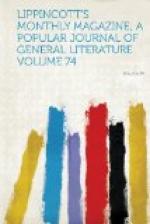[Illustration: Dublin exhibition building, 1853.]
In crude materials the Union is at home. It was so in 1851, and is still; but then it was not so much at home in anything else as now. We have advanced in that field too, since we sent no silver, and from Colorado no gold, no canned fruits, meats or fish, and no wine but some Cincinnati Catawba, thin and acid, according to the verdict of the imbibing jury. We adventured timidly into manufacturing competition with the McCormick reaper, which all Europe proceeded straightway to pirate; ten or twelve samples of cotton and three of woolen goods; Ericsson’s caloric-engine; a hydrostatic pump; some nautical instruments; Cornelius’s chandeliers for burning lard oil—now the light of other days, thanks to our new riches in kerosene; buggies of a tenuity so marvelous in Old-World eyes that their half-inch tires were likened to the miller of Ferrette’s legs, so thin that Talleyrand pronounced his standing an act of the most desperate bravery; soap enough to answer Coleridge’s cry for a detergent for the lower Rhine; and one bridge model, forerunner of the superb iron erections that have since leaped over rivers and ravines in hundreds.
Meagre enough was the display of our craftsmen by the side of that made by their brethren of the other side. It could have been scarce visible to Britannia, looking down from a pinnacle of calico ready for a year’s export over and above her home consumption, long enough, if unrolled, to put a girdle thirty times round the globe, though not all of it warranted to stand the washing-test that would be imposed by the briny part of the circuit.
And yet there were visible in the American department germs of original inventions and adaptations, the development and fructification of which in the near future were foreseen by acute observers. Our metallic life-boats were then unknown to other countries, those of England being all of wood. The screw-propeller was quite a new thing, though the Princeton had carried it, or been carried by it, into the Mediterranean ten years before. Engines designed for its propulsion




